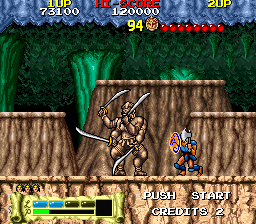Despite the title, Astyanax isn't about the son of Hector of Troy. The player controls a hero who must, as ever, hike across the land and battle monsters until he defeats a dark lord. The game, distributed by Jaleco and known in Japan as The Lord of King, was designed by Rastan's Toshiyuki Nishimura and Tokuhiro Takemori, with Takemori listed as director.
For a core game mechanic, Takemori brought a concept around which he'd based one of his previous games, The Legendary Axe, namely that the hero's axe has a power meter that charges up between attacks. The idea being that you have a choice between attacking a lot at low power, or saving up to unleash a much stronger blow. As it is, Astyanax is such a frantic game that most players will probably just hack away as fast as possible at the litany of foes coming from all sides. The player also can make limited use of a screen-clearing magical attack. Among the bosses are another instance of a multi-armed statue likely influenced by the Kali statue in The Golden Voyage of Sinbad, and a two-headed dragon.
Unlike some other games, Astyanax does follow a relatively consistent path in settings. The attract mode displays a huge tower rising on an island in the middle of a lake that is connected to the surrounding land by a long, narrow bridge. Indeed, the player starts out in a forested area, then moves through cave, then onto the bridge, then penetrating the castle/tower to meet the evil wizard. Because it was the 80s, the final level has the hero bust into a Giger-esque biomechanical hellhole and face skittering monsters that rear up to display mouths that look like vagina dentata, culminating in a battle against a final boss that attacks with an arm that extends across the screen, presumably because having its mouth shoot outward would have been a bit too much for the lawyers. With the job done, the tower and its island crumble and sink and the world is made safe again.
It's not a bad game, but it does overall feel inferior to the console games it's related to, both Legendary Axe for the PC Engine and the NES console port of Astyanax, which keeps the axe-charging mechanic and hack-and-slash gameplay but otherwise reworks the game quite a bit. The graphics in this arcade game are reasonably good, but it feels a bit rote in its side-scrolling design and it's so hyperactive that it renders the charge attack almost pointless.






No comments:
Post a Comment